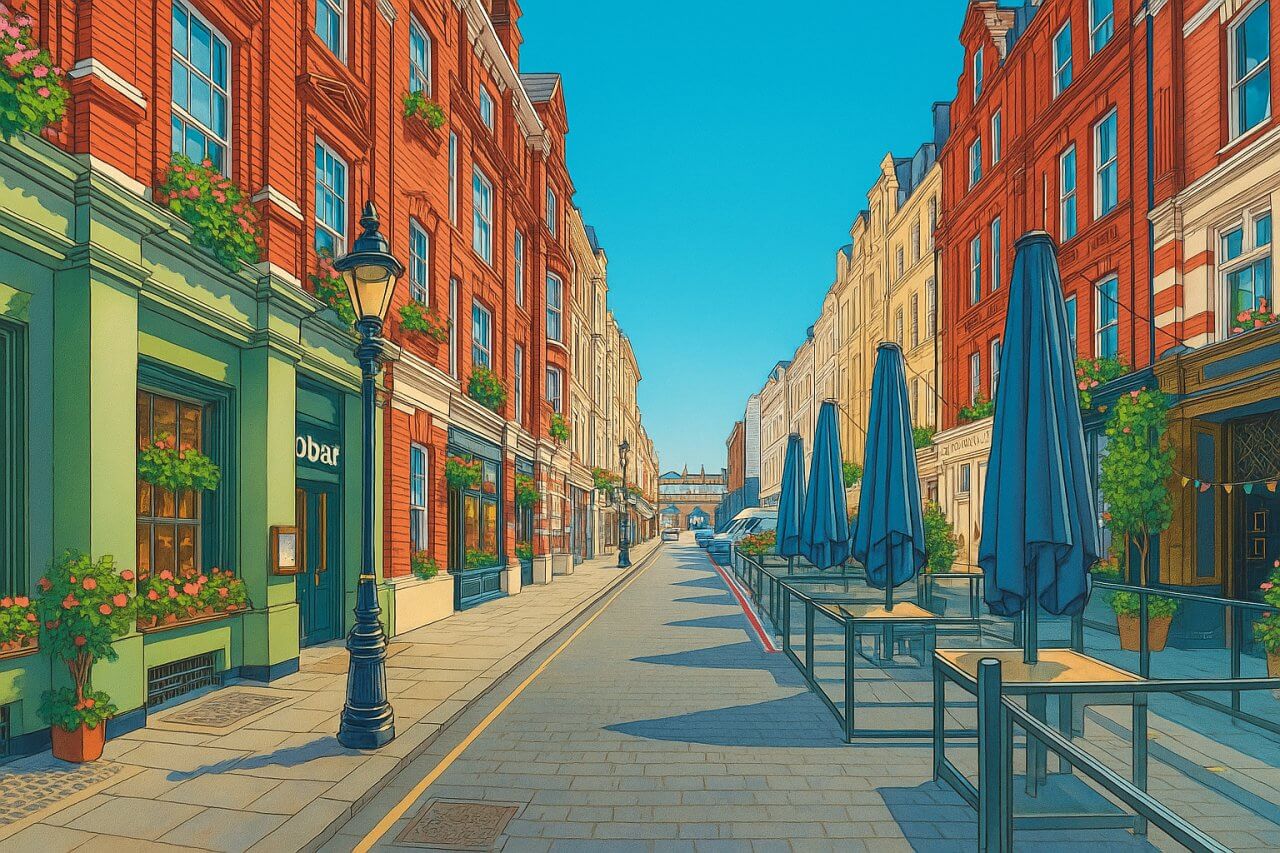
Henrietta Street, London
Henrietta Street is a short but historic street in the City of Westminster, located in the heart of London’s West End. It runs east to west, linking Bedford Street on its western end with Southampton Street on its eastern end, forming a vital part of the Covent Garden district’s network of narrow, atmospheric lanes.
Overview and Setting
Henrietta Street lies one block south of Covent Garden Piazza and is lined with historic architecture, boutique shops, restaurants, and offices. Despite its modest length—just a couple hundred metres—it serves as a vibrant pedestrian-friendly corridor nestled in one of London’s most iconic areas. The street sits parallel to King Street to the north and Maiden Lane to the south, creating a tightly woven urban grid filled with charm and activity.
The street maintains a classic London feel with cobblestones, Victorian façades, and traditional lamp posts, all of which contribute to its historic and cinematic appearance. Henrietta Street often features in period dramas and photo shoots for its quintessential London backdrop.
Name and Pronunciation
The name "Henrietta Street" is believed to honour Henrietta Maria, the French-born queen consort of King Charles I of England. Many nearby streets, such as King Street and Charles Street (now defunct), were similarly named during the 17th century. The name is typically pronounced as hen-ree-ET-uh, and in the International Phonetic Alphabet (IPA) it is /ˌhɛn.riˈɛtə/.
History of Henrietta Street
Henrietta Street was laid out in the 1630s, shortly after the development of Covent Garden by the Earl of Bedford. The Earl transformed the area from former convent grounds into London’s first planned residential square. Henrietta Street initially served as a fashionable residential address for the gentry and nobility. By the 18th and 19th centuries, it became known for its printshops, publishers, and small theatres.
Throughout the 19th century, Henrietta Street evolved from a primarily residential lane into a mixed-use zone, accommodating businesses and eateries. Its proximity to Covent Garden Market meant it played a role in London’s fruit and vegetable trade, with goods transported via handcarts and wagons.
Modern Character and Attractions
Today, Henrietta Street is best known for its vibrant mix of cafés, boutique fashion stores, and creative offices. Notable establishments include classic pubs like the *Porterhouse*, upscale dining at *Frenchie Covent Garden*, and premium menswear from *The Real McCoy’s*. The street is pedestrian-friendly and ideal for a leisurely stroll, especially for visitors exploring Covent Garden’s shopping and dining scene.
Points of interest within walking distance include:
- Covent Garden Piazza and Apple Market
- London Transport Museum
- Royal Opera House
- St Paul’s Church (commonly known as the Actors' Church)
Real Estate on Henrietta Street
Henrietta Street remains a prestigious address. Residential property is limited, and what little exists tends to be located above commercial ground-floor units. Flats here are typically conversions in period buildings. A one-bedroom flat might range from 550 to 750 square feet (51 to 70 sq metres), while two-bedroom flats can span 850 to 1,100 square feet (79 to 102 sq metres).
As of June 2025, properties on Henrietta Street command high prices typical of prime Central London. A one-bedroom flat is valued between £950,000 and £1.2 million, while larger flats can exceed £2 million. Monthly rents for one-bedroom flats range from £3,500 to £5,000, reflecting its central location and historic cachet.
Transport Links
Henrietta Street enjoys excellent access to the London Underground. The nearest station is Covent Garden Station (Piccadilly Line), which is just a few minutes’ walk away to the north. Leicester Square Station (serving the Northern and Piccadilly Lines) and Charing Cross Station (Bakerloo and Northern Lines, as well as National Rail services) are also nearby, providing fast connections across London.
Several bus stops are located around the Covent Garden area. Routes passing through the Strand and Aldwych—just a short walk from Henrietta Street—include services to Oxford Street, the City, and Waterloo.
Fun Fact
Henrietta Street was once home to a number of famous figures, including 18th-century novelist Henry Fielding. The area’s literary and artistic heritage remains strong, and remnants of its theatrical past are still reflected in nearby venues and street names.
Quick Facts
- Location: Covent Garden, City of Westminster, London
- Connects: Bedford Street (west) to Southampton Street (east)
- Pronunciation: hen-ree-ET-uh (/ˌhɛn.riˈɛtə/)
- Nearby Streets: King Street, Maiden Lane
- Notable Nearby Sights: Covent Garden Piazza, Royal Opera House, London Transport Museum
- Nearby Underground Stations: Covent Garden Station (Piccadilly Line), Leicester Square Station, Charing Cross Station
- Bus Routes: Available along Strand and Aldwych
- Property Prices (June 2025): £950,000–£2 million+ for flats; £3,500–£5,000 monthly rental
- Residential Unit Sizes: 550–1,100 sq ft (51–102 sq metres)
- Historic Fact: Named for Queen Henrietta Maria, laid out in the 1630s
Map of Henrietta Street, London
 Painting of Henrietta Street, London
Painting of Henrietta Street, London